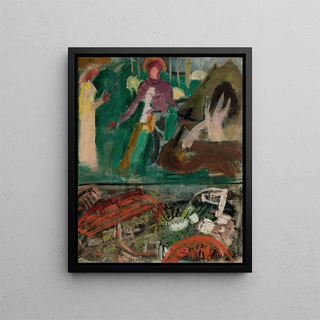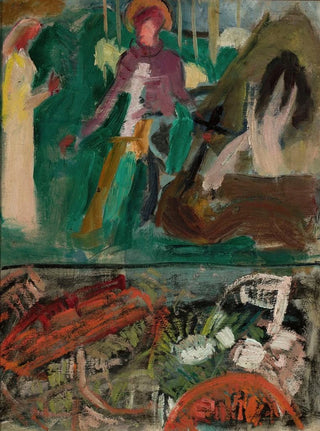Art print | Sketch for the painting Saint George piercing a dragon - Tadeusz Makowski


View from behind

Frame (optional)
In the vibrant universe of art, certain works stand out for their ability to capture the very essence of mythological stories and legends. The art print Esquisse pour le tableau Saint Georges perçant un dragon - Tadeusz Makowski is a striking example. This sketch, far from being a mere outline, reveals a world where imagination blends with reality, inviting the viewer to immerse themselves in a rich and evocative visual narrative. Saint Georges, an iconic figure in the fight against evil, is depicted here in an epic battle, a scene that transcends time and invites contemplation. Makowski's art, with its unique sensitivity, offers us a gateway to an era when legends came to life on canvas.
Style and uniqueness of the work
Tadeusz Makowski's work stands out for its expressive yet delicate style. In this art print, flowing lines and vibrant colors combine to bring to life a scene full of emotion. The movement of the horse, the determination of the saint, and the threat of the dragon are rendered with such intensity that they seem almost tangible. The composition, skillfully orchestrated, guides the viewer's gaze across the canvas, creating a dynamic that captures attention and stimulates imagination. What makes this art print unique is the way Makowski manages to blend tradition and modernity, revisiting a classic theme with a personal touch. The influences of Polish folk art mingle with elements of Western art, creating a fascinating dialogue between cultures.
The artist and his influence
Tadeusz Makowski, a Polish artist of the early 20th century, marked his era with an innovative approach and a unique artistic sensitivity. His career, though relatively short, was filled with creations that reflect deep thought on identity and culture. Makowski draws inspiration from Polish folk tradition while incorporating contemporary elements, allowing him to stand out in the artistic landscape of his time. His work, rich in symbols and stories, invites reflection on the

Matte finish

View from behind

Frame (optional)
In the vibrant universe of art, certain works stand out for their ability to capture the very essence of mythological stories and legends. The art print Esquisse pour le tableau Saint Georges perçant un dragon - Tadeusz Makowski is a striking example. This sketch, far from being a mere outline, reveals a world where imagination blends with reality, inviting the viewer to immerse themselves in a rich and evocative visual narrative. Saint Georges, an iconic figure in the fight against evil, is depicted here in an epic battle, a scene that transcends time and invites contemplation. Makowski's art, with its unique sensitivity, offers us a gateway to an era when legends came to life on canvas.
Style and uniqueness of the work
Tadeusz Makowski's work stands out for its expressive yet delicate style. In this art print, flowing lines and vibrant colors combine to bring to life a scene full of emotion. The movement of the horse, the determination of the saint, and the threat of the dragon are rendered with such intensity that they seem almost tangible. The composition, skillfully orchestrated, guides the viewer's gaze across the canvas, creating a dynamic that captures attention and stimulates imagination. What makes this art print unique is the way Makowski manages to blend tradition and modernity, revisiting a classic theme with a personal touch. The influences of Polish folk art mingle with elements of Western art, creating a fascinating dialogue between cultures.
The artist and his influence
Tadeusz Makowski, a Polish artist of the early 20th century, marked his era with an innovative approach and a unique artistic sensitivity. His career, though relatively short, was filled with creations that reflect deep thought on identity and culture. Makowski draws inspiration from Polish folk tradition while incorporating contemporary elements, allowing him to stand out in the artistic landscape of his time. His work, rich in symbols and stories, invites reflection on the






